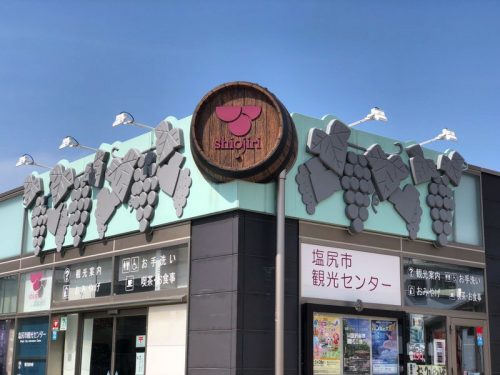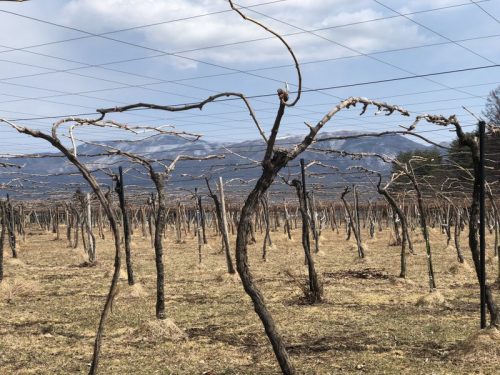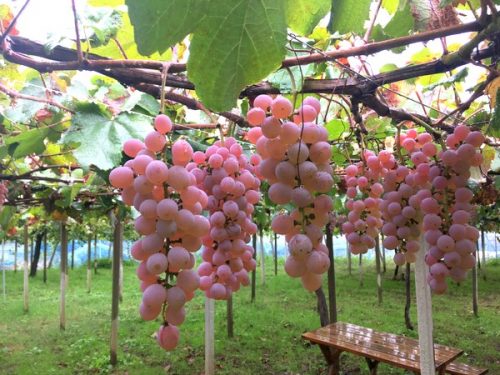
I’m in Japan. The purpose of this trip is to explore Nagano, which is one of the three main Japanese wine regions. Some perspective on the Japanese wine scene. Winegrowing started here 140 years ago under the strategy of the Meiji government (the Meiji era began in 1868). They wanted to encourage new industry, and wine was targeted. Things began in the Yamanashi prefecture in 1874, and to this day, with its Koshu wine, it’s the best known of Japan’s wine regions internationally. But there are two other regions that are emerging with perhaps more potential: Nagano and Hokkaido.
Wine here is quite a new industry, and in recent years there has been a drastic change, with a move towards making more wines from Japanese-grown grapes as opposed to imported concentrate. For many years Japan relied on foreign grapes sources for its wineries. Even now only 20% of domestic production is proper Japanese wine, making wine from Japan-grown grapes.
Since 2000 there has been a rapid increase in the number of wineries wineries and there’s been increasing interest on trying to make authentic wines. There have been more than 100 new wineries, with Nagano and Hokkaido growing the fastest. Many of these producers are operating on a tiny scale. The largest winery (making only Japanese wine) is Hokkaido Wine, with 2.6 million bottles per year, but they are unusual: this is a country where many things are done on a precision scale.

Initially, most of the new wineries were focusing on Chardonnay and Merlot, the two most popular vinifera varieties. But this is changing, and people are looking to discover the varieties best suited to their places. I have even heard of some producers who are working with Trousseau. There is also a lot of interest in natural wine, although this can be a polarizing topic.

One of the serious problems is the quality and availability of planting material. There are around 20 nurseries supplying grape vines, but they also sell other plant materials and aren’t specialists. There is only one nursery where you can order by clone, and the virus-checking system hasn’t been developed enough.
Production of proper Japanese wine:
22 million bottles per year
- 7 million from Yamanashi (33%)
- 4.9 million from Nagano (22%)
- 3.3 million from Hokkaido (15%)
- 1.6 million from Yamagata (7%)
- 0.8 million from Iwate (4%)
- 0.6 million from Nigata (3%)
There are 82 wineries in Yamanashi, 36 in Nagano, 34 in Hokkaido, 13 in Yamagata, 10 in Iwate, and 10 in Nigata. In total, as of 2016 there were 280 wineries, but this is growing. Nagano itself has three large wineries – Alps Wines, Hayashi and Izutsu – and then the rest are small.
Japan has a fairly restricted set of grape varieties at the moment. Chardonnay, Pinot Gris, Sauvignon Blanc and Kerner are the main vinifera white varieties, while reds are Merlot, Cabernet Sauvignon, Cabernet Franc and Pinot Noir. In addition to the vinifera varieties, there are the hybrids and labruscas that have been popular because they are relatively disease resistant.

The most famous, the pink-skinned big-berried Koshu, is a hybrid, although the Yamanashi growers prefer it to be described as vinifera – it is one quarter is Vitis davidi, which is a wild grape from southern China. The most common red hybrid is also big berried, and it is Muscat Bailey A. It can make some really nice wines if handled well.
Then we have the Labrusca varieties – Campbell Early, Niagara and Delaware.
The most widely vinified grapes
- Koshu (16.1%)
- Muscat Bailey A (14.2%)
- Niagara
- Concord
- Delaware
- Merlot (6.2%, increasing)
- Chardonnay (5.6%, increasing)
The climate varies quite a bit, but one common feature is regular rainfall during the growing season, which can be a problem. There is a 23 degree difference in latitude between Okinawa and Hokkaido, whereas France spans just 6 degrees. There are also differences in altitude too, with vineyards from 26 m up to 1000 m.
So, why should I be interested in Japanese wine? This is a small industry, and it’s unlikely that many of the wines will be exported. And don’t we already have enough diversity in the world of wine?
I care, because this is just the sort of wine scene that interests me. It is in its early stages, it is dynamic, and it is growing. And it is being driven by people who care about wine and want to make something interesting. As a journalist, this sort of scene is golden! Lots to explore, and the path is relatively untrodden. The quality so far is variable, but it is improving, and I’m very excited to explore and discover. And in a small way, I want to help the good producers get the attention and rewards they deserve.
Today is day two on the ground here, and I’m looking forward to some new discoveries.
7 Comments on Japan: an overview of Japanese wine, and why we should be interested
I’m also captivated by Japanese wine, both the autochthonous varieties and the European vinifera interlopers. I’d been seeking it out for years, both here and in Japan, but it was only last year I actually visited a vineyard, Domaine Sogga in Nagano Province (at Obuse). I hit gold, as Jasper Morris and others later informed me.
You mention natural wines, but there is also biodynamics. And adding to your grape varieties i can add Albariño, Viognier and the Mansengs. Excuse my excitement as I follow your journey with real interest.
Thank you on the article on wines from Japan. On my last trip to Tokyo I was introduced to a very nice Pinot Noir made by winemaker Bruce Gutlove.
Bruce
May I suggest to visit the winery of a friend of mine, we studied oenology together in Montpellier back in 2002-3: Atsuo Hirakawa. It is for sure worth a visit if you want to meet passionate producers in Japan!
Thank you for the article about Japanese wines. I met you at Gabrielkloof in South Africa a few weeks ago and now you are in Japan ! Our northern island’s name is Hokkaido (I would like to suggest a little spelling correction). I hope you will have a chance to visit there, too
Articles like this definitely inspire the anorak within! I was interested to see that the Koshu variety now has more provenance, as the only info I had was that it was vinifera of some sort but as yet unidentified. Do you know any more about the varieties make up? Thanks Jamie
Fascinating, Jamie.
When do Japanese drink wines? Is there a food and wine matching culture? Do restaurants list wines? Japanese wines?
Recently had a Tamba Sauvignon Blanc at Motoi in Kyoto. A wonderful example of a crisp and varietally correct Sauv Blanc that could be served with pride anywhere.